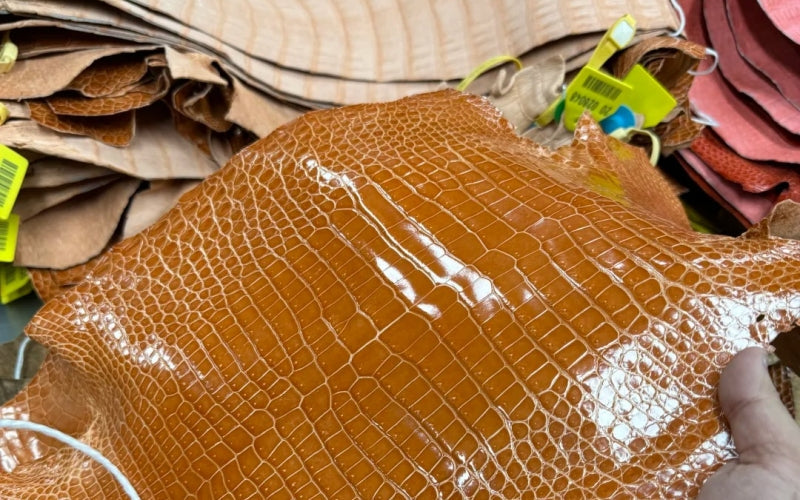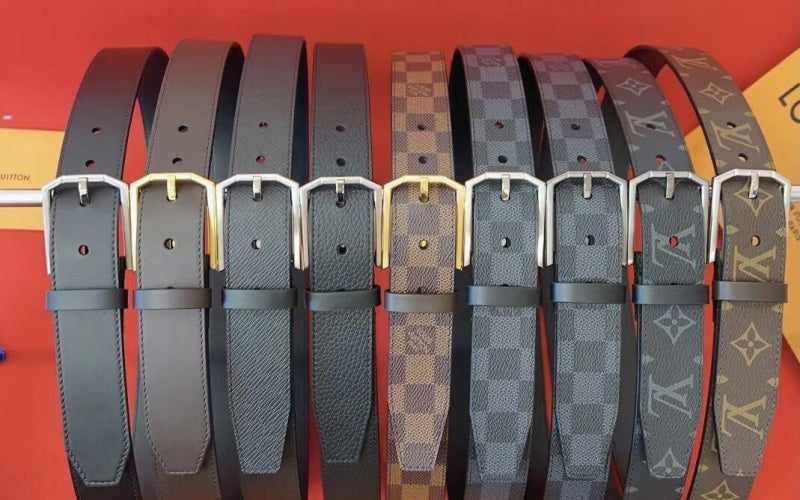Article: Is It Alligator or Crocodile? A Quick Guide to the 4 Leathers You'll Encounter

Is It Alligator or Crocodile? A Quick Guide to the 4 Leathers You'll Encounter
Step into the world of luxury goods, and you’ll inevitably encounter the unparalleled prestige of exotic leathers.
Among them, alligator and crocodile skins reign supreme, symbolizing status, craftsmanship, and timeless elegance. However, for the untrained eye, the terms are often used interchangeably, yet they represent distinct species with unique characteristics and values.
Whether you're investing in a belt, a handbag, or a pair of bespoke shoes, understanding the difference is key.
This guide will demystify the four most prominent types used in high-end leather goods: Siamese Crocodile, Saltwater Crocodile, Nile Crocodile, and the American Alligator.
1. Saltwater (Porosus) Crocodile
-
Scientific Name: Crocodylus porosus
-
Industry Terms: Saltwater Crocodile or, more commonly in luxury circles, Porosus Crocodile. The term "Porosus" is derived directly from its scientific name and signifies the highest grade.
Often hailed as the "king of exotic leathers," Porosus crocodile is the most valuable and sought-after skin in the world. Its reputation is built on the flawless quality and exquisite beauty of its scales.

Key Identifying Features:
-
Scale Pattern: The belly scales are small, symmetrical, and perfectly uniform, with a round or fine oval shape. This creates a refined and intricate pattern.
-
The Hallmark Pore: The most definitive characteristic is a tiny, visible dot known as a follicle pore on nearly every scale. This is a remnant of a sensory hair that the crocodile has in the wild. Its consistent presence is the unmistakable signature of a true crocodile. Check the picture below carefully!
-
Top-Tier Luxury: This is the leather of choice for the most exclusive creations from brands like Hermès, particularly for their iconic Birkin and Kelly bags.
2. Nile (Niloticus) Crocodile
-
Scientific Name: Crocodylus niloticus
-
Industry Terms: Nile Crocodile or Niloticus Crocodile. "Niloticus" is the preferred term used by luxury brands to denote this specific origin.
A close contender for the top spot, Niloticus is another premier leather celebrated for its quality and versatility. It offers a slightly different aesthetic from Porosus but is held in similarly high regard.

Key Identifying Features:
-
Scale Pattern: The belly scales are slightly larger and more square-shaped compared to the finer scales of the Porosus. The pattern remains exceptionally clean and symmetrical.
-
The Follicle Pore: Like the Saltwater Crocodile, the Nile Crocodile also features the signature follicle pore on its scales, confirming its status as a "true crocodile."
-
Luxury Mainstay: It is widely used by top-tier luxury houses for a range of goods, offering a classic and bold look.


3. Siamese Crocodile
-
Scientific Name: Crocodylus siamensis
-
Industry Term: Siamese Crocodile.
The Siamese Crocodile is a workhorse in the high-end leather market, especially popular in Asia and Europe. It provides an excellent balance of quality, beauty, and accessibility, making it a more common but still luxurious choice.

Key Identifying Features:
-
Scale Pattern: The scale pattern is very similar to that of the Nile Crocodile, featuring clean, square-like belly scales.
-
The Follicle Pore: As a true crocodile, its scales are also marked with the characteristic follicle pore.
-
Market Position: While highly valued, it is generally considered a step below Porosus and Niloticus in the luxury hierarchy, offering a superb yet more attainable option for premium goods.

4. American Alligator
-
Scientific Name: Alligator mississippiensis
-
Industry Term: American Alligator.
It is crucial to note that this is an alligator, not a crocodile. Belonging to the Alligatoridae family, its skin has a fundamentally different characteristic that makes it instantly identifiable and highly prized for its unique, clean aesthetic.

Key Identifying Features:
-
Scale Pattern: The American Alligator boasts large, square, and beautifully symmetrical belly scales. The skin is known for its supple, buttery texture and rich, glossy finish.
-
The Definitive Difference: No Pore: This is the absolute key identifier. The belly scales of an American Alligator are perfectly smooth and do not have the follicle pore. This clean, unblemished surface gives it a distinct and highly coveted look.
-
Elite Status: Valued on par with Nile Crocodile, American Alligator is a favorite for luxury watch straps, belts, and handbags due to its flawless, classic appearance.


Summary Table: At a Glance
| Common Name | Industry/Brand Term | Scientific Name | Key Identifying Features (Belly Scales) |
| Saltwater Crocodile | Porosus Crocodile | Crocodylus porosus | Small, round/oval scales. Visible follicle pore. The most premium skin. |
| Nile Crocodile | Niloticus Crocodile | Crocodylus niloticus | Square-shaped scales, larger than Porosus. Visible follicle pore. |
| Siamese Crocodile | Siamese Crocodile | Crocodylus siamensis | Square-shaped scales, similar to Nile. Visible follicle pore. |
| American Alligator | American Alligator | Alligator mississippiensis | Smooth, square scales. Completely absent of follicle pores. |

Buyer Beware: The Caiman Deception
In your search for exotic leather, you will frequently encounter "Caiman crocodile." It's essential to understand that Caiman is not a luxury-grade leather, despite being a member of the alligator family. Unscrupulous sellers often misrepresent Caiman skin as the more desirable Siamese or even the premium Nile Crocodile to deceive customers.
The primary lure is its incredibly low price. Here’s why you should be cautious:
-
Inferior Quality: Caiman belly skin contains bony plates (osteoderms) that make the leather stiff, brittle, and prone to cracking over time, especially in the creases between the scales. True luxury crocodile and alligator skins are prized for their soft, pliable belly hides.
-
The Price Red Flag: This is the clearest indicator of a scam. Genuine Nile Crocodile leather, for example, has a very high raw material cost. If you find a product advertised as "Nile Crocodile" at a price that seems too good to be true, it is almost certainly a lower-grade Caiman skin. A genuine article simply cannot be produced for that price.
-
How to Spot It: Look for a rigid texture, small "pockmarks" or pits on the scales left by the bony deposits, and a less uniform, more chaotic scale pattern compared to the pristine leathers below.


Always be vigilant. Now that you know what to avoid, let's explore the 4 most prominent types of genuine luxury skins used in high-end leather goods.
Conclusion: The Pore is the Telltale Sign
When navigating the world of exotic leathers, the simplest rule to remember is "the pore rule." If you see the small, distinct follicle pore on the scales, you are looking at a true crocodile (Porosus, Niloticus, or Siamese). If the scales are perfectly smooth and unblemished, you have an American Alligator.
By understanding these distinctions, you can not only appreciate the unique beauty of each skin but also make an informed and confident choice in your next luxury investment.
Please share this post! It took me 8 hours to finish this post!!!!


